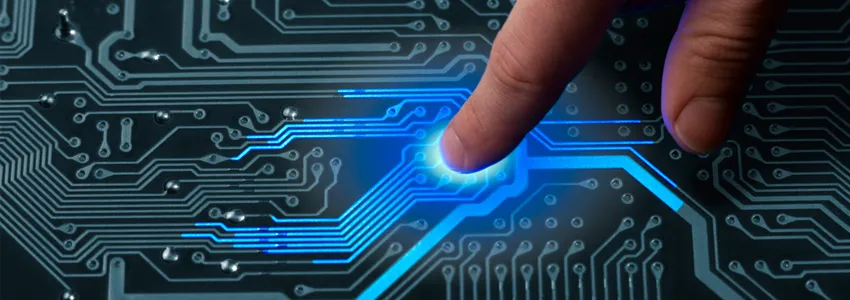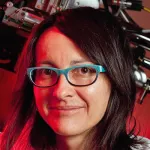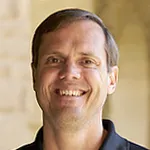
Image by Your lucky photo, Shutterstock: Researchers are developing quantum computers based on light rather than electricity. At Stanford, new materials could be the key to progress in this field.
Stanford News - May 9th, 2017 - by Tom Abate
For 60 years computers have become smaller, faster and cheaper. But engineers are approaching the limits of how small they can make silicon transistors and how quickly they can push electricity through devices to create digital ones and zeros.
That limitation is why Stanford electrical engineering Professor Jelena Vuckovic is looking to quantum computing, which is based on light rather than electricity. Quantum computers work by isolating spinning electrons inside a new type of semiconductor material. When a laser strikes the electron, it reveals which way it is spinning by emitting one or more quanta, or particles, of light. Those spin states replace the ones and zeros of traditional computing.
Vuckovic, who is one of the world’s leading researchers in the field, said quantum computing is ideal for studying biological systems, doing cryptography or data mining – in fact, solving any problem with many variables.
“When people talk about finding a needle in a haystack, that’s where quantum computing comes in,” she said.
Marina Radulaski, a postdoctoral fellow in Vuckovic’s lab, said the problem-solving potential of quantum computers stems from the complexity of the laser-electron interactions at the core of the concept.
“With electronics you have zeros and ones,” Radulaski said. “But when the laser hits the electron in a quantum system, it creates many possible spin states, and that greater range of possibilities forms the basis for more complex computing.”
Capturing electrons
Harnessing information based on the interactions of light and electrons is easier said than done. Some of the world’s leading technology companies are trying to build massive quantum computers that rely on materials super-cooled to near absolute zero, the theoretical temperature at which atoms would cease to move.
In her own studies of nearly 20 years, Vuckovic has focused on one aspect of the challenge: creating new types of quantum computer chips that would become the building blocks of future systems.
“To fully realize the promise of quantum computing we will have to develop technologies that can operate in normal environments,” she said. “The materials we are exploring bring us closer toward finding tomorrow’s quantum processor.”
The challenge for Vuckovic’s team is developing materials that can trap a single, isolated electron. Working with collaborators worldwide, they have recently tested three different approaches to the problem, one of which can operate at room temperature – a critical step if quantum computing is going to become a practical tool.
In all three cases the group started with semiconductor crystals, material with a regular atomic lattice like the girders of a skyscraper. By slightly altering this lattice, they sought to create a structure in which the atomic forces exerted by the material could confine a spinning electron.
“We are trying to develop the basic working unit of a quantum chip, the equivalent of the transistor on a silicon chip,” Vuckovic said.
Quantum dots
One way to create this laser-electron interaction chamber is through a structure known as a quantum dot. Physically, the quantum dot is a small amount of indium arsenide inside a crystal of gallium arsenide. The atomic properties of the two materials are known to trap a spinning electron.
In a recent paper in Nature Physics, Kevin Fischer, a graduate student in the Vuckovic lab, describes how the laser-electron processes can be exploited within such a quantum dot to control the input and output of light. By sending more laser power to the quantum dot, the researchers could force it to emit exactly two photons rather than one. They say the quantum dot has practical advantages over other leading quantum computing platforms but still requires cryogenic cooling, so it may not be useful for general-purpose computing. However, it could have applications in creating tamper-proof communications networks.
Color centers
In two other papers Vuckovic took a different approach to electron capture, by modifying a single crystal to trap light in what is called a color center.
In a recent paper published in NanoLetters, her team focused on color centers in diamond. In nature the crystalline lattice of a diamond consists of carbon atoms. Jingyuan Linda Zhang, a graduate student in Vuckovic’s lab, described how a 16-member research team replaced some of those carbon atoms with silicon atoms. This one alteration created color centers that effectively trapped spinning electrons in the diamond lattice.
But like the quantum dot, most diamond color center experiments require cryogenic cooling. Though that is an improvement over other approaches that required even more elaborate cooling, Vuckovic wanted to do better.
So she worked with another global team to experiment with a third material, silicon carbide. Commonly known as carborundum, silicon carbide is a hard, transparent crystal used to make clutch plates, brake pads and bulletproof vests. Prior research had shown that silicon carbide could be modified to create color centers at room temperature. But this potential had not yet been made efficient enough to yield a quantum chip.
Vuckovic’s team knocked certain silicon atoms out of the silicon carbide lattice in a way that created highly efficient color centers. They also fabricated nanowire structures around the color centers to improve the extraction of photons. Radulaski was the first author on that experiment, which is described in another NanoLetters paper. She said the net results – an efficient color center, operating at room temperature, in a material familiar to industry – were huge pluses.
“We think we’ve demonstrated a practical approach to making a quantum chip,” Radulaski said.
But the field is still in its early days and electron tapping is no simple feat. Even the researchers aren’t sure which method or methods will win out.
“We don’t know yet which approach is best, so we continue to experiment,” Vuckovic said.
The diamond research team included Stanford faculty members Zhi-Xun Shen, the Paul Pigott Professor in Physical Sciences, professor of photon science, of physics and of applied physics, and a senior fellow at the Precourt Institute for Energy; Nicholas Melosh, an associate professor of materials science and engineering and of photon science; and Steven Chu, the William R. Kenan Jr. Professor, professor of physics and of molecular and cellular physiology, and member of Stanford Bio-X and the Stanford Neurosciences Institute.



